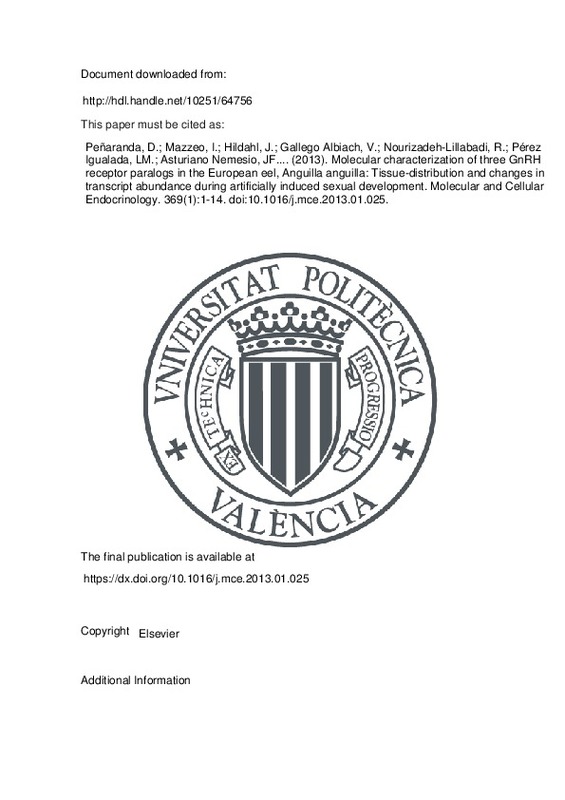JavaScript is disabled for your browser. Some features of this site may not work without it.
Buscar en RiuNet
Listar
Mi cuenta
Estadísticas
Ayuda RiuNet
Admin. UPV
Molecular characterization of three GnRH receptor paralogs in the European eel, Anguilla anguilla: Tissue-distribution and changes in transcript abundance during artificially induced sexual development
Mostrar el registro sencillo del ítem
Ficheros en el ítem
| dc.contributor.author | Peñaranda, D.S.
|
es_ES |
| dc.contributor.author | Mazzeo, Ilaria
|
es_ES |
| dc.contributor.author | Hildahl, Jon
|
es_ES |
| dc.contributor.author | Gallego Albiach, Victor
|
es_ES |
| dc.contributor.author | Nourizadeh-Lillabadi, Rasoul
|
es_ES |
| dc.contributor.author | Pérez Igualada, Luz María
|
es_ES |
| dc.contributor.author | Asturiano Nemesio, Juan Francisco
|
es_ES |
| dc.contributor.author | Weltzien, Finn-Arne
|
es_ES |
| dc.date.accessioned | 2016-05-26T09:12:18Z | |
| dc.date.available | 2016-05-26T09:12:18Z | |
| dc.date.issued | 2013-04-30 | |
| dc.identifier.issn | 0303-7207 | |
| dc.identifier.uri | http://hdl.handle.net/10251/64756 | |
| dc.description.abstract | [EN] Gonadotropin-releasing hormone receptor (GnRH-R) activation stimulates synthesis and release of gonadotropins in the vertebrate pituitary and also mediates other processes both in the brain and in peripheral tissues. To better understand the differential function of multiple GnRH-R paralogs, three GnRH-R genes (gnrhr1a, 1b, and 2) were isolated and characterized in the European eel. All three gnrhr genes were expressed in the brain and pituitary of pre-pubertal eels, and also in several peripheral tissues, notably gills and kidneys. During hormonally induced sexual maturation, pituitary expression of gnrhr1a (female) and gnrhr2 (male and female) was up-regulated in parallel with gonad development. In the brain, a clear regulation during maturation was seen only for gnrhr2 in the midbrain, with highest levels recorded during early vitellogenesis. These data suggest that GnRH-R2 is the likely hypophysiotropic GnRH-R in male eel, while both GnRH-R1a and GnRH-R2 seems to play this role in female eels. | es_ES |
| dc.description.sponsorship | aa-gnrhr2 Primers were obtained from a partial sequence kindly provided by Dr. Kataaki Okubo (University of Tokyo, Japan). The fish farm Valenciana de Acuicultura, S.A. supplied the male fish used in the described experiments. This work was funded by the European Community's 7th Framework Program under the Theme 2 "Food, Agriculture and Fisheries, and Biotechnology", Grant Agreement No. 245257 (Pro-Eel) and Generalitat Valenciana (ACOMP/2012/086 and I.M. Predoctoral Grant). D.S.P. has a postdoc Grant from UPV (CEI-01-10), mobility grants from UPV (PAID-00-11) and the Research Council of Norway (EJ/hsm IS-STP, 2009) and also has been supported by a contract co-financed by MICINN and UPV (PTA2011-4948-I). V.G. and I.M. have predoctoral grants from Spanish Ministry of Science and Innovation (MICINN), Generalitat Valenciana, and UPV PAID Programme (2011-S2-02-6521), while F.-A.W. was funded by the Norwegian School of Veterinary Science. | en_EN |
| dc.language | Inglés | es_ES |
| dc.publisher | Elsevier | es_ES |
| dc.relation.ispartof | Molecular and Cellular Endocrinology | es_ES |
| dc.rights | Reserva de todos los derechos | es_ES |
| dc.subject | Gene expression | es_ES |
| dc.subject | Gonad maturation | es_ES |
| dc.subject | Brain | es_ES |
| dc.subject | qPCR | es_ES |
| dc.subject | Screening Sequence | es_ES |
| dc.subject.classification | BIOLOGIA ANIMAL | es_ES |
| dc.subject.classification | PRODUCCION ANIMAL | es_ES |
| dc.title | Molecular characterization of three GnRH receptor paralogs in the European eel, Anguilla anguilla: Tissue-distribution and changes in transcript abundance during artificially induced sexual development | es_ES |
| dc.type | Artículo | es_ES |
| dc.identifier.doi | 10.1016/j.mce.2013.01.025 | |
| dc.relation.projectID | info:eu-repo/grantAgreement/EC/FP7/245257/EU/Reproduction of European Eel: Towards a Self-sustained Aquaculture/ | es_ES |
| dc.relation.projectID | info:eu-repo/grantAgreement/UPV//PAID-00-11/ | es_ES |
| dc.relation.projectID | info:eu-repo/grantAgreement/UPV//CE-01-10/ | es_ES |
| dc.relation.projectID | info:eu-repo/grantAgreement/GVA//ACOMP%2F2012%2F086/ | es_ES |
| dc.relation.projectID | info:eu-repo/grantAgreement/MICINN//PTA2011-4948-I/ES/PTA2011-4948-I/ | es_ES |
| dc.relation.projectID | info:eu-repo/grantAgreement/UPV//PAID-2011-S2-02-6521/ | es_ES |
| dc.rights.accessRights | Abierto | es_ES |
| dc.contributor.affiliation | Universitat Politècnica de València. Instituto de Ciencia y Tecnología Animal - Institut de Ciència i Tecnologia Animal | es_ES |
| dc.contributor.affiliation | Universitat Politècnica de València. Departamento de Ciencia Animal - Departament de Ciència Animal | es_ES |
| dc.description.bibliographicCitation | Peñaranda, D.; Mazzeo, I.; Hildahl, J.; Gallego Albiach, V.; Nourizadeh-Lillabadi, R.; Pérez Igualada, LM.; Asturiano Nemesio, JF.... (2013). Molecular characterization of three GnRH receptor paralogs in the European eel, Anguilla anguilla: Tissue-distribution and changes in transcript abundance during artificially induced sexual development. Molecular and Cellular Endocrinology. 369(1):1-14. https://doi.org/10.1016/j.mce.2013.01.025 | es_ES |
| dc.description.accrualMethod | S | es_ES |
| dc.relation.publisherversion | https://dx.doi.org/10.1016/j.mce.2013.01.025 | es_ES |
| dc.description.upvformatpinicio | 1 | es_ES |
| dc.description.upvformatpfin | 14 | es_ES |
| dc.type.version | info:eu-repo/semantics/publishedVersion | es_ES |
| dc.description.volume | 369 | es_ES |
| dc.description.issue | 1 | es_ES |
| dc.relation.senia | 253791 | es_ES |
| dc.contributor.funder | European Commission | |
| dc.contributor.funder | Generalitat Valenciana | |
| dc.contributor.funder | Universitat Politècnica de València | |
| dc.contributor.funder | Ministerio de Ciencia e Innovación | |
| dc.contributor.funder | Research Council of Norway |







![[Cerrado]](/themes/UPV/images/candado.png)

